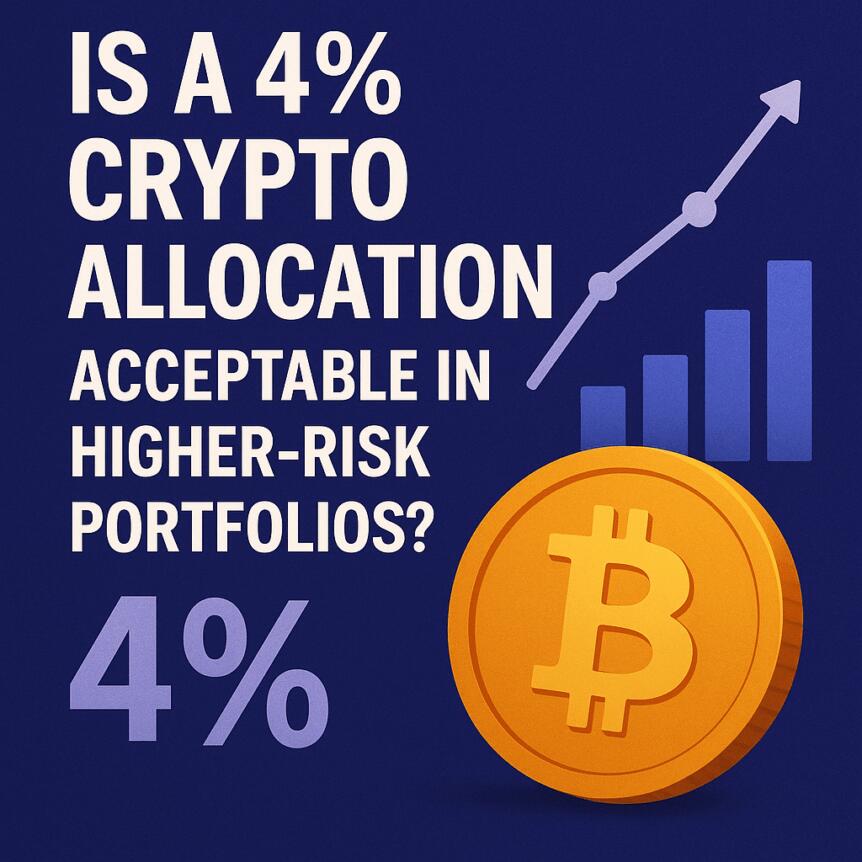Is a 4% Crypto Allocation Acceptable in Higher-Risk Portfolios?

Certainly! Here’s the rewritten article with the requested enhancements:
—
## Morgan Stanley Provides Guidance on Cryptocurrency Allocations in Multi-Asset Portfolios
In a recent move highlighting the increasing mainstream acceptance of digital assets, Morgan Stanley released guidelines for cryptocurrency investments within diversified portfolios. The investment giant recommends a cautious approach, emphasizing modest allocations to manage the inherent volatility of cryptocurrencies amidst evolving regulatory landscapes and market dynamics.
- Morgan Stanley suggests up to 4% allocation for cryptocurrencies in high-risk portfolios.
- A 2% allocation is recommended for moderate, balanced growth portfolios.
- The report advises zero crypto exposure for portfolios focused on wealth preservation.
- Institutional adoption of crypto continues to grow, reinforcing its legitimacy as an asset class.
- Bitcoin is recognized as digital gold, with the coin hitting new all-time highs amid macroeconomic tensions.
Financial services heavyweight Morgan Stanley has issued new investment guidelines for incorporating cryptocurrencies into multi-asset portfolios. In its October Global Investment Committee (GIC) report, the firm advocates a conservative stance, suggesting that investors consider modest allocation percentages due to potential volatility and macroeconomic uncertainties.
The analysts recommend that “Opportunistic Growth” portfolios, which aim for higher risk and higher returns, allocate up to 4% of assets to cryptocurrencies. Meanwhile, “Balanced Growth” portfolios should limit crypto exposure to 2%, reflecting a more moderate risk approach. For portfolios dedicated to wealth preservation or income, the guidance is to exclude cryptocurrencies entirely, citing concerns over increased volatility and correlation during market stress. The report cautions:
Morgan Stanley GIC guidelines for maximum crypto allocations in investment portfolios. Source: Hunter HorsleyHunter Horsley, CEO of investment firm Bitwise, praised the report’s significance, calling it “huge” news. He highlighted that Morgan Stanley’s GIC influences roughly 16,000 advisors managing approximately $2 trillion in client assets, signaling a broader acceptance of cryptocurrencies in mainstream investment strategies. “We’re now entering the mainstream era,” Horsley stated.
The report underscores the continued institutional adoption of crypto assets, especially among major banks and financial institutions, which bolsters the asset class’s credibility. This trend is seen as fueled by the rising presence of large-scale investments and increased regulatory clarity, setting the stage for further capital inflows into digital markets.
Morgan Stanley Describes Bitcoin as Digital Gold as It Reaches New All-Time Highs
Bitcoin (BTC) remains at the forefront of institutional crypto adoption, with Morgan Stanley characterizing it as “a scarce asset, akin to digital gold.” The cryptocurrency continues to attract major treasury reserves and investment funds, including exchange-traded funds (ETFs), reinforcing its status as a store of value.
Recently, Bitcoin surged to a new all-time high exceeding $125,000, according to data from Glassnode. This rally coincided with a significant decline in Bitcoin exchange balances, indicating that coins are being held for longer-term investment rather than trading. The surge occurred amid a backdrop of macroeconomic turbulence, including a U.S. government shutdown and rising inflation, prompting investors to flock toward perceived safe-haven assets.
Market analysts from The Kobeissi Letter observed that the current wave of asset inflows is driven by concerns over inflation and economic uncertainty, with some predicting Bitcoin could reach a future target of $250,000—a “best case” scenario for many traders.
For a deeper analysis of Bitcoin’s rally and the broader crypto market trends, watch this expert discussion:
In the evolving landscape of crypto regulation and institutional acceptance, Bitcoin’s narrative as digital gold solidifies, while markets respond to macroeconomic shifts with increasing interest in blockchain-based assets.
This article was originally published as Is a 4% Crypto Allocation Acceptable in Higher-Risk Portfolios? on Crypto Breaking News – your trusted source for crypto news, Bitcoin news, and blockchain updates.
You May Also Like

Here’s Why Mantle (MNT) Price Is Pumping Today

Cashing In On University Patents Means Giving Up On Our Innovation Future
